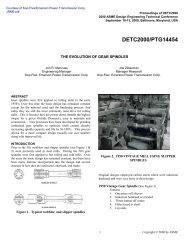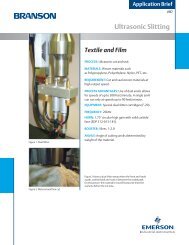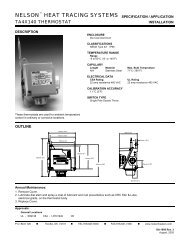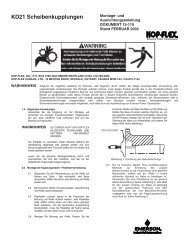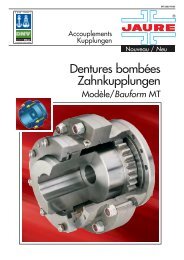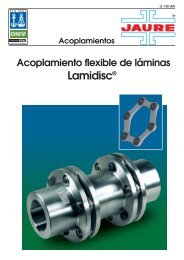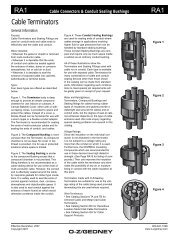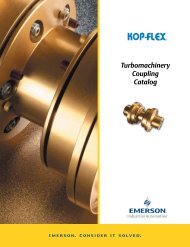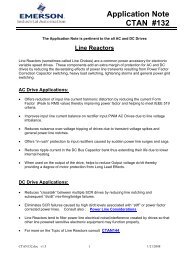Kop-Flex Industrial Coupling Product Catalog - Form 8887E
Kop-Flex Industrial Coupling Product Catalog - Form 8887E
Kop-Flex Industrial Coupling Product Catalog - Form 8887E
Create successful ePaper yourself
Turn your PDF publications into a flip-book with our unique Google optimized e-Paper software.
Optimizing gear tooth design to maximize<br />
performance<br />
A spindle’s load capacity depends on:<br />
(1) how well the gear teeth mesh<br />
(2) the physical properties of each tooth<br />
(1) Gear mesh depends on misalignment and<br />
tooth shape<br />
Misalignment - impacts the number of teeth in<br />
contact.<br />
In the plane of misalignment, only a few opposing teeth<br />
on the spindle’s hub gear contact the sleeve before<br />
torque is applied. As torque is applied, these gear<br />
teeth deflect which brings adjacent teeth into contact<br />
with the sleeve. The degree of misalignment partly<br />
determines the number of teeth in contact for a given<br />
amount of torque. The lower the angle, the more teeth<br />
in contact. Conversely, the higher the angle the fewer<br />
teeth in contact. The more teeth in contact, the greater<br />
the torque capacity.<br />
Gear Spindles<br />
Technical Advantages<br />
Tooth shape - Number of teeth in contact<br />
Tooth thickness at the root (with misalignment and other<br />
factors) determines the amount the tooth will deflect<br />
under load. A certain degree of deflection will maximize<br />
the number of teeth in contact.<br />
20° PRESSURE ANGLE 25° PRESSURE ANGLE<br />
Gear spindles commonly use a pressure angle of either<br />
20° or 25°. A 20° pressure angle tooth is thinner at the<br />
root and will deflect more under load than a 25° tooth.<br />
On the other hand, a 25° tooth will resist tooth breakage<br />
better. In general, a 20° pressure angle is better for<br />
compressive load distribution (resistance to wear), while<br />
a 25° pressure angle will better resist tooth breakage.<br />
Tooth shape - Manner of contact<br />
We crown the flanks of spindle teeth and pilot either the<br />
tips or the roots. Proper flank crowning prevents tooth<br />
end bending, reduces contact stress, and increases the<br />
contact area by moving the load closer to the center of<br />
the tooth. Piloting and flank crowning also prevent<br />
jamming. Teeth could otherwise meet off center and lock<br />
under torque. Finally, piloting and flank crowning reduce<br />
the amount of backlash required, which can reduce the<br />
torque amplification factor. This improves the finish of<br />
the products being rolled.<br />
The required maximum angle of misalignment (usually<br />
the roll change angle) determines the amount of flank<br />
crown required. If the flank crown doesn’t suit the roll<br />
change angle, teeth could break at roll change.<br />
HERTZ (CONTACT) STRESS ON GEAR TOOTH<br />
Nitrided spindles tend to use 20° pressure angle teeth<br />
for a better load distribution, while carburized spindles<br />
tend to have 25° pressure angle teeth.<br />
It’s important to remember to NEVER MIX 20° AND 25°<br />
PARTS, since they will not fit together.<br />
(2) How a spindle’s physical properties affect load<br />
capacity<br />
The physical properties of a spindle depend on the<br />
material, the heat treatment, and the process used to<br />
shape teeth after heat treatment.<br />
Many alloys are used to make spindles, each with<br />
its own inherent core strength and other properties.<br />
Manufacturers then usually harden the teeth to increase<br />
wear resistance and strength, using either induction<br />
hardening, nitriding, or carburizing. The effects of each<br />
type of heat treatment differ for each alloy. One can’t<br />
simply compare one material with another. You have<br />
to consider the material and treatment in combination.<br />
194





